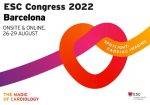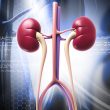Heart disease is the most frequent cause of heart failure and, in some observational studies, transluminal coronary angioplasty (TCA) could help improve ventricular function. The only major randomized study to compare myocardial revascularization surgery (MRS) vs. medical treatment in patients with ventricular function impairment was the STICH study, which showed no difference at 5 years,...
ESC 2022 | Should We Follow-Up with Functional Testing in High-Risk Patients after CTA?
While the need for repeat cinecoronary angiography after transluminal coronary angioplasty (TCA) has decreased with the use of drug-eluting stents and improved medical treatment, patients still present ischemic recurrence or cardiovascular events at follow-up. Using a functional test at follow-up after TCA or myocardial revascularization (CMR) is a frequent practice in our context. This is...
RADIANCE-HTN SOLO: Control Durability of BP
In patients with hard-to-control high blood pressure (HBP), both non-pharmacological treatment and lifestyle changes have been useful to improve its control. Renal denevartion (RDN) was assessed as part of this complementary treatment, since some research has shown that this alternative decreases blood pressure (BP) values in different groups treated with either radiofrequency or ultrasound (uRDN)....
Clinical Results of IVUS-Guided Drug-Eluting Stent Implantation in Femoropopliteal Disease
Endovascular treatment of femoropopliteal lesions has become the first-line treatment due to the development of devices that decrease the restenosis rate. Recently, the IMPERIAL study showed greater patency at 1 year and greater freedom from clinically guided revascularization at 2 years in favor of the ELUVIA stent (paclitaxel-eluting fluoropolymer, FP-DES) compared with the ZILVER PTX...
MitraClip in Patients with COPD: a Valid Option
Chronic obstructive pulmonary disease (COPD) and cardiovascular disease are associated to hospitalization and mortality. When associated to severe mitral regurgitation, not only do these two conditions have poor evolution, but they also limit the possibility of surgical valve replacement, given its high risk. Edge-to-edge repair with MitraClip has been shown beneficial in a group of...
The Best of the SOLACI-SOCIME 2022 Main Arena: PCI by Radial Access
Angioplasty by transradial access was discussed during a session on Day 2. We were pleased to participate in a conference by Dr. Shigeru Saito on distal radial access. Currently, complications associated with transfemoral access are well-established, so transradial access is suggested as the initial strategy in several guidelines of various associations. However, Dr. Saito shared...
DISRUPT-PAD III: Followup of IVL Treatment in Femoropopliteal Territory
Femoropopliteal segment calcification can generate complications for both preparation and execution of endovascular therapies for patients with peripheral artery disease. It can produce suboptimal vessel expansion associated to higher risk of dissection or perforation. These adverse effects can affect procedure durability in the long term. Studies on the use of drug coated balloons to treat...
Thin vs. Ultrathin Stents: 1-Year Clinical Results After IVUS/OCT-Guided Implantation
Second generation drug-eluting stents have lower frequency of thrombotic complications and in-stent restenosis. While clinical results have significantly improved, having a 2-3% annual rate of these complications within the first year after angioplasty is still worrisome. This resulted in the development of stents with struts <70 µm (ultrathin), with bioresorbable polymer and abluminal cover. Stents...
Same Day Discharge in NSTE-ACS: Is It Possible?
At present, percutaneous coronary intervention (PCI) is the most common coronary revascularization strategy. One of its benefits is that patients can be safely discharged when procedures are programed, which helps decompress hospital capacity. However, this strategy has not been validated for acute coronary syndromes; the evidence gathered for non-ST elevation ACS is far from robust,...
Thromboendarterectomy vs. Endovascular Therapy in Common Femoropopliteal Territory. Is Surgery Still the Gold Standard?
For lesions in the common femoral artery, guidelines recommend surgical endarterectomy (TEA) as the gold standard. However, endovascular therapy (EVT) is an alternative option for these lesions. In 2017 the first randomized study comparing TEA vs EVT was carried out, showing that EVT presents clinical benefits, though it does not replace surgical treatment as first...









